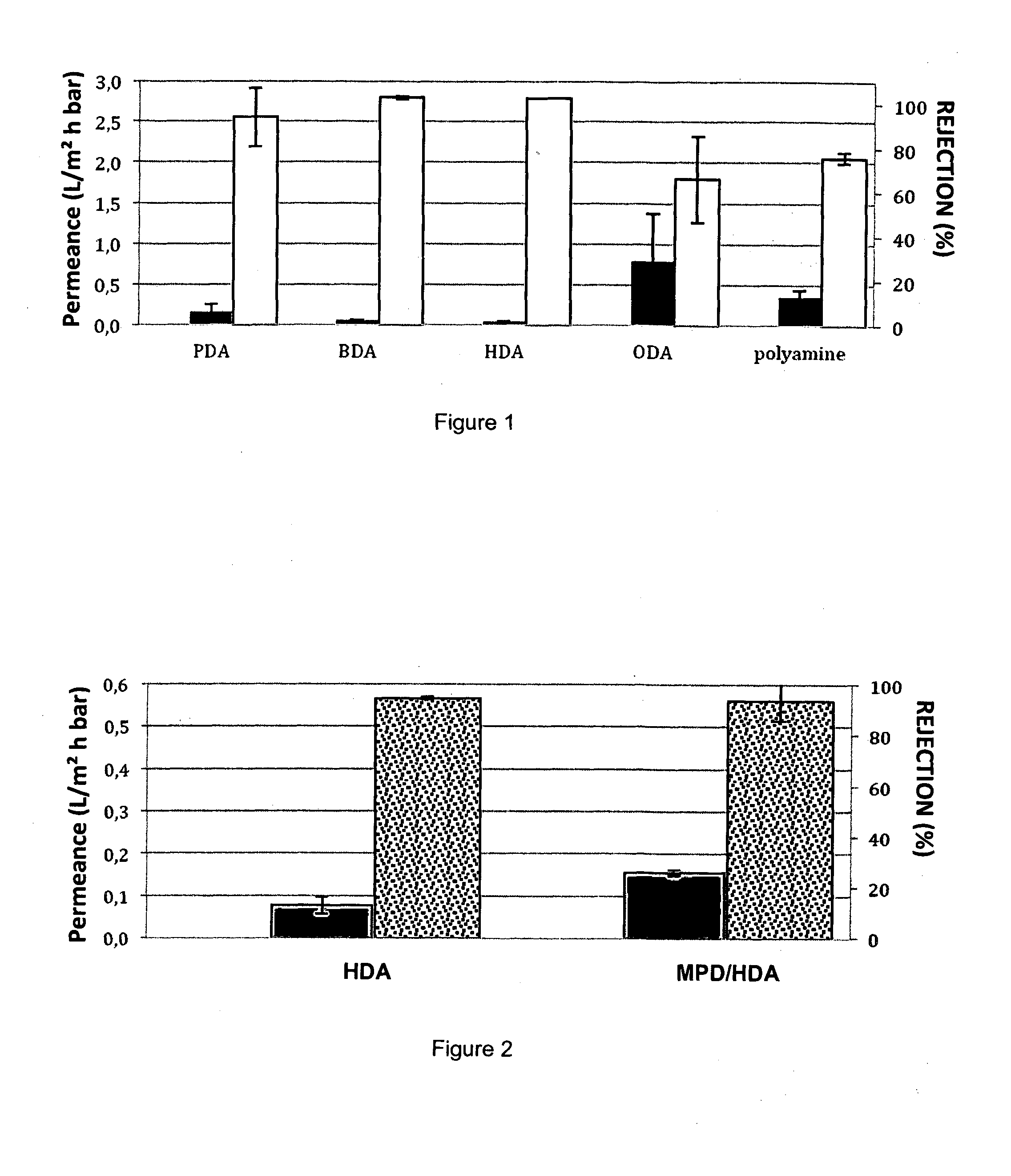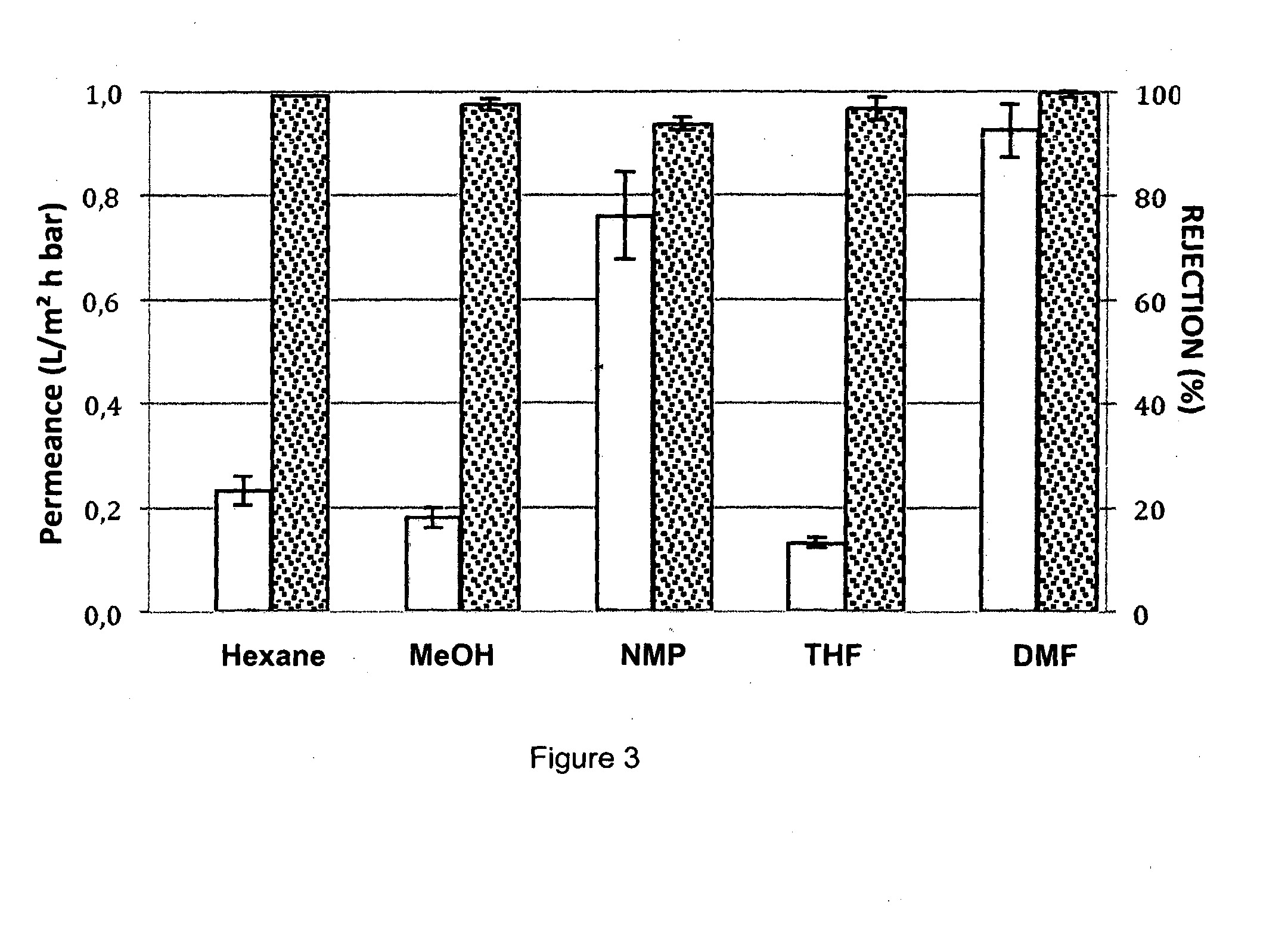Method for synthesis of thin film composite membranes
a thin film composite and membrane technology, applied in membrane technology, membranes, coatings, etc., can solve the problems of relatively poor performance and/or stability of membrane in organic solvents, not widely applied to the separation of solutes in organic solvents, and not widely applied to membrane separation. , to achieve the effect of increasing the resistance to (organic) solvents
- Summary
- Abstract
- Description
- Claims
- Application Information
AI Technical Summary
Benefits of technology
Problems solved by technology
Method used
Image
Examples
example 1
Thin Film Composite Membranes—PA Layer on PI-Support
[0080](Solvent resistant) TFC membranes comprising a PA layer on a (cross-linked) polyimide support were prepared as follows:
[0081]A polymer dope solution was prepared by dissolving 12 wt %, 14 wt %, 16 wt % or 18 wt % polyimide (Matrimid® 9725 US (Huntsman)) in N-methyl-2-pyrrolidone / tetrahydrofuran (NMP / THF ratio of 3 / 1) until complete dissolution. The viscous polymer solution was allowed to stand for several hours to remove air bubbles. The dope solution was then cast onto a porous non-woven PP / PE supporting substrate (Novatexx 2471, Freudenberg). After a short evaporation step (0, 10, 20, 30; 60 s) (wherein the cast film is exposed to air and some of the volatile THF is removed from the top layer) the cast film is immersed (for 30 min) in a coagulation solution whereby phase inversion occurs.
[0082]In the SIM method, coagulation, crosslinking & membrane saturation occurs in a single step. The casted film is immersed in an aqueou...
example 2
PA-PI TFC Membranes—MPD / HDA as Coagulation Medium
[0090]PA-(crosslinked)PI TFC membranes were prepared as in example 2 according to the SIM method. The casted film is immersed in an aqueous amine solution consisting of MPD (2 wt %) & HDA (0.1-1.0 wt %) solution (for 30 min). Stability measurements of the formed membranes showed that with 0.5 wt % HDA in the aqueous coagulation medium the crosslinked membranes showed 98% stability in DMF. Higher HDA percentages did not further increase membrane stability in DMF.
[0091]Filtration characteristics were analysed using a PA-PI TFC membrane prepared according to the SIM method (example 2), using an aqueous MPD (2 wt %) / HDA (0.5 wt %) solution as phase inversion medium.
[0092]Comparison of the filtration characteristics of the support membrane prepared by the SIM methode (example 2) with 2 wt % HDA or 2 wt % MPD+0.5 wt % HDA showed that RB rejection was similar for both membranes, but the EtOH permeance was lower for the MPD / HDA PI support mem...
example 3
Post-Preparation Treatment of TFC Membranes
[0094]The membranes prepared in example 3 showed good rejection properties but rather low permeances. Several post-preparation treatments were investigated for their impact on the permeance properties. PA-PI TFC membranes prepared as described in example 3 were (after storage in water) equilibrated with DMF (dimethylformamide); THF; NMP; hexane; or methanol, prior to the filtration experiments (RB in EtOH)
[0095]A 12 h DMF pre-equilibration resulted in an about 8-fold increase in EtOH permeance, while RB rejection remained high (<95%), compared to the membrane stored in water. A 24 h DMF pre-equilibration resulted in an about 30 fold increase in EtOH permeance, while RB rejection was not much affected. Similar observation (increasing permeances & no or increasing rejection upon DMF treatment) were made with MeOH and IPA as feed solutions.
[0096]A 12 h pre-equilibration of the PA-PI TFC membranes (MPD / HDA) in different solvents (FIG. 3) also r...
PUM
| Property | Measurement | Unit |
|---|---|---|
| weight percent | aaaaa | aaaaa |
| molecular weight | aaaaa | aaaaa |
| weight percent | aaaaa | aaaaa |
Abstract
Description
Claims
Application Information
 Login to View More
Login to View More - R&D
- Intellectual Property
- Life Sciences
- Materials
- Tech Scout
- Unparalleled Data Quality
- Higher Quality Content
- 60% Fewer Hallucinations
Browse by: Latest US Patents, China's latest patents, Technical Efficacy Thesaurus, Application Domain, Technology Topic, Popular Technical Reports.
© 2025 PatSnap. All rights reserved.Legal|Privacy policy|Modern Slavery Act Transparency Statement|Sitemap|About US| Contact US: help@patsnap.com



